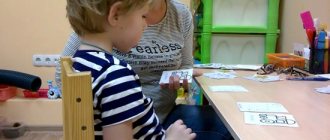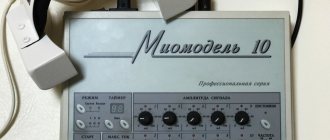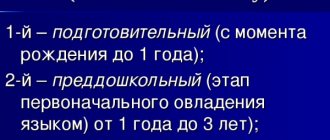Organization of group work in a speech therapy session article on speech therapy
Efimova Ulyana Sergeevna
Teacher speech therapist
GBDOU No. 145 combined type
Central region
Currently, the number of children with various speech disorders in children has increased significantly. Without corrective influence, such deviations interfere with the development of social experience and reduce the possibility of social rehabilitation and adaptation. Successful progression and mastery of a language requires specific, intentional learning.
Speech therapy is the science of speech disorders, methods of their prevention, identification and elimination by means of special training and education. Speech therapy studies the causes, mechanisms, symptoms, course, structure of speech disorders, and the system of correctional interventions. Working with a speech therapist in preschool age is the foundation for the child’s further speech development, because It is the basis for corrective speech therapy assistance for writing and reading disorders (dysgraphia and dyslexia) at school age.
Speech therapy work is an activity that, in parallel with the educational process, contributes to the successful acquisition of full speech skills. This is what makes the work of a preschool speech therapist relevant and in demand.
The goal of speech therapy classes in preschool age is to correct speech disorders, develop correct and beautiful speech in children, and prepare for learning to read and write.
The main tasks of speech therapy work:
- learning the correct pronunciation of all sounds;
- development of fine motor skills - stimulating the fingers activates the brain;
- development of coherent speech: construction of simple and compound sentences, replenishment of active vocabulary, ability to retell;
- development of phonetic hearing
- formation and improvement of impressive speech
The organization of speech therapy work in a group is built taking into account the age and psychological characteristics of children.
Younger age 3-4 years:
- Formation of speech hearing - the ability to understand spoken speech;
- development of auditory attention;
- expansion of vocabulary;
- development of fine motor skills of the hands and articulatory motor skills.
Average age 4-5 years:
- Formation of coherent speech: construction of phrases with and without prepositions, complex sentences;
- improving sound pronunciation;
- learning to build cause-and-effect relationships in statements (stories based on pictures);
- development of auditory-verbal attention and memory;
- development of speech breathing, voice, articulation.
Senior age 5-7 years:
- Formation of phonetic-phonemic hearing: the child determines by ear the quantity and quality of sounds and syllables in a word;
- correction of remaining deficiencies in children’s speech development (pronunciation of sounds, formation of word forms);
- Preparation for teaching literacy: introduction to the sound analysis of words.
Types of speech therapy classes:
- Individual
- Subgroup
- Frontal (group)
Frontal classes are a collective form of work that is carried out with students of speech therapy groups. The speech therapist draws up a calendar and thematic lesson plan, taking into account the individual characteristics and correctional needs of children. Frontal classes are held several times a week, children prepare for them in individual and subgroup classes with a speech therapist, and then reinforce the exercises with the teacher. Types of frontal classes for a speech therapy group:
- on the formation of lexical and grammatical means: enrichment of the dictionary and the formation of the grammatical structure of speech;
- on the formation of the sound structure of speech: correct pronunciation and analysis of sounds;
- on the development of coherent speech: independent construction of statements
The number and duration of frontal lessons depends on the age, psychological and individual characteristics of the children, and on the complexity of the learning task. In each age group, classes have their own characteristics, both in terms of time and organization.
The speech therapist needs:
1. clearly define the topic and purpose of the lesson;
2. highlight the nominative, predicative, attributive vocabulary that children must learn in active speech;
3. select lexical and grammatical material taking into account the topic and purpose of classes, the stage of remedial education, an individual approach to the speech and mental capabilities of children (in this case, non-normative phonetic formatting of part of the speech material is allowed);
4. identify the main stages of the lesson, showing their interrelation and interdependence, and formulate the purpose of each stage;
5. emphasize the presence of a teaching moment and consistent reinforcement of new material;
6. ensure a gradual change in types of speech and verbal-mental tasks of increasing complexity;
7. include in the lesson a variety of game and didactic exercises with elements of competition, control over your own actions and the actions of your friends;
8. when selecting program material, take into account the preschooler’s zone of proximal development, potential opportunities for the development of mental activity, complex forms of perception, and imagination;
9. provide techniques that ensure, with an individual approach to children, their involvement in active speech and cognitive activity;
10. include regular repetition of learned speech material.
Classes have a certain structure, which is largely dictated by the content of training and the specifics of the children’s activities. Regardless of these factors, in any lesson there are three main parts, inextricably linked by general content and methodology, namely:
the beginning, the course of the lesson (process) and the end.
The beginning of a lesson involves the immediate organization of children: it is necessary to switch their attention to the upcoming activity, arouse interest in it, create an appropriate emotional mood, and reveal the educational task.
The course of a lesson is an independent mental or practical activity of children, which consists in mastering knowledge and skills that are determined by the educational task. At this stage of the lesson, techniques and teaching are individualized in accordance with the level of development, pace of perception, and thinking characteristics of each child.
The end of the lesson is devoted to summing up and assessing the results of children's educational activities. The quality of the result obtained depends on the age and individual characteristics of the children, and on the complexity of the learning task.
Depending on the section of training and the goals of the lesson, the methodology for conducting each part of the lesson may be different. Private methods provide more specific recommendations for conducting each part of the lesson. After the lesson, the speech therapist analyzes its effectiveness, the children’s mastery of program tasks, reflects on the activity and outlines the prospects for the activity.
Additional factors that ensure the productivity of frontal forms of speech therapy classes with preschoolers are:
- free placement of children during classes (in a circle, semicircle, near the speech therapist, which allows them to examine the objects being studied, look at each other, at the speech therapist;
-a clear and logical system for selecting questions addressed to children;
- a variety of manuals, as well as preliminary selection of material for the lesson;
-focus on the common interests of children in order to enhance their expression;
-a gradual increase in the emotional intensity of the lesson: the most interesting fragments of the work correspond to the period of increasing fatigue;
-correctness in correcting children’s speech and other mistakes.
The requirements for frontal speech therapy classes are:
1. The lesson should be dynamic.
2. Game fragments and surprise moments must be included. You can include funny situations in which children will be participants.
3. There should be a frequent change of different activities.
4. It is necessary to develop a communicative orientation in children, teach them to communicate with the teacher and with each other.
5. During classes, it is necessary to teach children to listen, hear, and correct mistakes in other people’s speech and in their own.
6. Use a variety of teaching materials, colorful and convenient.
7. The most important thing is that children should talk a lot during classes.
Thus, the organization of speech therapy work in correctional groups of a preschool educational institution presupposes systematicity, purposefulness and phasing. The system of speech therapy work is based on an individually differentiated personal approach, which makes it possible to satisfy the needs and interests of each child, take into account his individual characteristics, and carry out targeted and effective speech correction in preschool children.
Speech therapy is the science of speech disorders, methods of their prevention, identification and elimination by means of special training and education, which studies: the causes, mechanisms, symptoms of speech disorders, course, structure. The term “Speech Therapy” consists of two Greek words: “Logos” - word, “Paideo” - educate.
On the basis of speech and its semantic unit - words, mental processes such as perception, imagination, memory are formed and developed. L. S. Vygotsky repeatedly pointed out that the development of oral speech is probably the most convenient phenomenon in order to trace the mechanism of behavior formation and compare the typical approach to thinking and personality formation for the study of conditioned reflexes with the psychological approach to them. The development of speech represents, first of all, the history of how one of the most important functions of a child’s cultural behavior is formed, which lies at the basis of the accumulation of his cultural experience.
Speech therapy assistance is a type of medical and pedagogical assistance provided to persons suffering from speech disorders of functional or organic origin (dyslalia, logoneurosis, aphasia, dysarthria, etc.). Timely therapeutic and corrective measures can accelerate the development of speech in children or eliminate acquired speech disorders in adults, and prevent secondary changes in intelligence caused by speech disorders.
The first special preschool institutions in our country were nurseries for children who stutter, where work was carried out under the methodological guidance of E.F. Pay (1932), and a semi-hospital speech therapy facility for stuttering preschoolers, organized on the initiative of the famous psychiatrist and public figure V.A. Gilyarovsky (1930). It used the one developed by Professor N.A. Vlasov’s comprehensive method of overcoming stuttering in children.
For a long time (60s), speech therapy assistance to children with other speech defects (dyslalia, dysarthria, alalia, etc.) was provided only in experimental groups or on an outpatient basis in children's clinics, which did not fully meet the needs of the population and did not provide full correction of speech disorders by the time the child enters school.
The subsequent period is characterized by a deep, comprehensive study of various forms of speech pathology in children of preschool and school age. It ended with the creation of a pedagogical classification of speech disorders. Based on a scientifically developed typology of children with speech defects, it became possible to substantiate the development of a differentiated network of preschool institutions for persons with various forms of speech disorders.
In the 70s intensive development of a specialized network began
Currently, in light of the implementation of the Federal State Standard for Preschool Education (clause 2.11.2), correctional work is aimed at ensuring the correction of developmental disorders of various categories of children who have the status of children with disabilities. The pupil’s diversified development is carried out taking into account age and individual characteristics, special educational needs and social adaptation.
In order to carry out correctional work, a speech therapy center operates on the basis of our preschool educational organization, which provides an individualized and systematic approach to the correction of speech disorders.
A speech therapist working at a speech center in an inclusive education setting, taking into account the specifics of the child’s defect, works in close collaboration with other specialists of the institution (music and physical education directors, doctors), parents and group teachers, regularly informs them about certain problems that arise in the process of correctional education. work.
At the present stage, speech therapy centers, in which speech therapy work is carried out by a specialist in eliminating speech disorders in preschool children, at mass general education kindergartens, are being reduced, which does not make it possible to cover a much larger contingent of children with speech therapy examination. To ensure efficient spending of budget funds, it is planned to merge speech therapy kindergartens with general developmental kindergartens; accordingly, there is a reduction in the staffing of speech therapist teachers. However, despite these difficulties, our city still has speech therapy centers and groups where speech therapy work is carried out with children with speech disorders. We propose to consider the concept of “speech therapy work” - this is an activity that, in parallel with the educational process, contributes to a more accessible and successful mastery of certain categories of children.
The goal of speech therapy work is the early identification and overcoming of deviations in the development of oral speech in preschool children.
The tasks that a speech therapist implements during his work in a general education kindergarten:
- diagnostics of children's speech development;
- social adaptation of children in a team;
- formation of communication abilities;
- developing the ability to collaborate;
- implementation of the necessary correction of speech disorders in children;
- creation of a developing subject-spatial environment and conditions for enriched, varied activities of children;
- determination and implementation of an individual route for correction and compensation of a speech defect, taking into account its structure, conditionality, as well as the individual personal characteristics of children;
- organizing the interaction of all subjects of the correctional educational process in implementing an integrated approach to the rehabilitation of children with speech development problems;
- interaction with the families of pupils to ensure the full, harmonious development of children, developing a competent pedagogical position in relation to their own child.
The principles of speech therapy work mean the starting points that determine the joint work of the speech therapist and the child in speech correction.
Currently, the basic principles of speech therapy work are identified, these include:
- The principle of systematicity takes into account the structures of various defects, determines the leading violation and correlates primary and secondary defects. Speech is a complex mental process, therefore, even if its individual links are disrupted, as a rule, all speech activity as a whole is disrupted. This determines a systematic approach to eliminating speech disorders.
- The principle of a differentiated approach is carried out taking into account the etiology of the disorder, symptoms, structure of speech defects, individual and age characteristics of the child. In the process of speech therapy work, it is important to take into account the level of speech development, characteristics of mental processes, and the level of cognitive activity.
- The principle of phasing is a complex process of speech therapy intervention, i.e., correction of deficiencies occurs in several stages. Each stage has its own tasks, methods and techniques for correction. There is a gradual transition from one stage to the next - from simpler to more complex.
- The ontogenetic principle, i.e. the speech therapist must take into account the development of speech in ontogenesis, from simple to complex. Sounds in a child’s speech need to be corrected in the same sequence in which they appeared during the child’s development.
- The principle of natural speech communication presupposes various situations in which the child finds himself. The child’s environment should be informed about the type of defect, tasks, methods of work and work closely with the speech therapist.
Having examined the concept of speech therapy assistance, and having studied the main goals, objectives and principles of work of a speech therapist in a general preschool educational institution, we will move on to the next section, devoted to the methods of work of a speech therapist with children in a preschool institution.
A method is a systematized set of steps and actions that are aimed at solving a specific problem or achieving a specific goal.
Speech therapy intervention is a pedagogical process, the main forms of which are education, training, correction, compensation, adaptation, rehabilitation. Speech therapy intervention is carried out in the following forms of training: frontal, subgroup, lesson, individual lesson.
Impact is the active influence of a subject on an object, not necessarily explicit or with feedback. Speech therapy intervention is carried out using various methods: practical, visual, verbal.
The choice and use of one or another method is determined by the nature of the speech disorder, the content, goals and objectives of correctional speech therapy, the stage of work, the age, individual psychological characteristics of the child, etc. At each stage of speech therapy work, the effectiveness of mastering correct speech skills is ensured by the corresponding group of methods . Thus, the stage of sound production is characterized by the predominant use of practical and visual methods; When automating, especially in connected speech, conversation, retelling, story, i.e., verbal methods are widely used.
When eliminating stuttering in preschool age, the effectiveness of speech therapy work is achieved by practical and visual methods.
1. Practical methods of speech therapy include exercises, games and modeling.
- Exercise is the child’s repeated repetition of practical and mental actions.
- Game, as a method, involves a combination of various components of gaming activity with other techniques: demonstration, explanation, instructions, questions.
- Modeling, as a method of speech therapy intervention, is the process of creating models and using them to form ideas about the structure of objects, the relationships and connections between the elements of these objects.
2. Visual methods are those forms of assimilation of knowledge, skills and abilities that are significantly dependent on the visual aids and technical means of teaching speech therapy influences on individual speech disorders used in teaching.
Visual methods include observations, looking at drawings, paintings, models, watching videos, listening to audio recordings, as well as showing a sample task, a method of action, which in some cases act as independent methods.
3. Features of the use of verbal methods in speech therapy work are determined by the age characteristics of the children, the structure and nature of the speech defect, goals, objectives, and the stage of correctional intervention. When working with preschool children, verbal methods are combined with practical and visual ones. The main verbal methods are story, conversation, reading.
- A story is a form of teaching in which the presentation is descriptive.
- Conversation is a method of obtaining information based on verbal communication.
- Reading is a complex cognitive process of symbol decoding aimed at understanding text.
When assessing a child’s activity, it is necessary to take into account his age and individual psychological characteristics. Unconfident, shy, and acutely aware of their defects should be more often encouraged to show pedagogical tact when assessing their work.
Thus, we reviewed the main sections of this topic. The above information has been studied and analyzed in comparison of theory and practice. Preschool educational institutions and speech centers for children with speech disorders are the first stage of lifelong education and are part of the public preschool education system. Correctional speech therapy work in preschool institutions plays a leading role in the education and development of preschool children if they have speech underdevelopment and secondary psychological deviations in overcoming and compensating them.








